
I heard a song today and at some point the lyrics say “I’ve been saved by a woman”... It reminded me of my own story… How many times have I been saved by Mary? How many graces have I received through her intercession? How many times have I felt her love pouring over me? There are too many to count. And I know it is the same for all of us.
Well, I've been saved by a woman
I've been saved by a woman
I've been saved by a woman
(Ray Lamontagne)
So this May, we will be sending HER some love, paying back a little of our debt towards her.
From May 4th to 31st on Perifmedia, discover the stories of the four most famous icons of the Theotokos: Our Lady of Smolensk, Our Lady of Tender Mercy, Our Lady of the Protection and Our Lady of the sign. We will also pray with the Akathist Hymn to the Theotokos, sending Mary “flowers” of worship, as tokens of our love.
Come back to this page for the daily flower, starting May 4th!
In March of 1898 a group of anarchists, desiring to undermine the faith of the people in the miraculous icon, decided to destroy it. They placed a bomb in the Cathedral of the Sign, and at two o'clock in the morning a horrendous explosion ripped the air, shaking the walls of the monastery. The force of the blast had shattered the gilded canopy above the icon. The heavy marble base had been jolted out of position and split into several pieces and a huge metal candlestick, which stood before the icon had been blown to the opposite side of the cathedral. A door of cast iron located near the icon had been torn from its hinges and cast outside, where it smashed against a wall and caused a deep crack. Amid the general devastation, the holy icon remained intact and even the glass within the frame remained whole. In their efforts to destroy the icon, the anarchists had, on the contrary, become the cause of its greater glorification...
In the year of 1383, the province of Kursk was subjected to a new invasion by the Golden Horde under their leader, Khan Tokhtamysh. The Tatars decided to set fire to the chapel, to burn down this icon who was protecting the province. In spite of all of their efforts, the chapel refused to burn. So the Tartars accused the priest Bogoliub of sorcery. The pious priest denounced their foolishness and pointed instead to the will of the miraculous icon, but that only served to infuriate the malicious Tartars, who got a hold of the icon and cut it in two, casting the pieces to either side. Only then did the chapel catch fire, and the priest Bogoliub was made a prisoner...
As soon as Prince Vasily Shemyaka of Rylsk heard of the miracles operated by the icon of Our Lady of the Sign, he ordered that the icon be brought into the city of Rylsk. This was done in a most solemn manner, with a grand procession through the city and everyone coming to greet the icon of the Mother of God on its way; but the prince himself declined to attend the festivities and for this reason he was punished with blindness. Realizing his mistake, he repented and immediately recovered his sight. Moved by this miracle, Shemyaka constructed a church in the city of Rylsk in honor of the Nativity of the Holy Theotokos, and there the miraculous icon was enshrined on September 8th, the day of its manifestation...
Icon of the Mother of God of “Kursk-Root”
The Kursk Root Icon of the Theotokos “Of the Sign” is also one of the most ancient icons of the Russian Church. In the thirteenth century during the Tatar invasion, when all of Russia was facing their most brutal tribulations yet, the province of Kursk, ravaged by the soldiers of the Mongol leader Batu Khan, fell into desolation. The towns were emptied, and wilderness returned to the province. The residents of Rylsk, the only town preserved from the invasion, often went to hunt in the territories of the province of Kursk...
The icon of Our Lady of the sign depicts the Theotokos at the Annunciation, at the moment when Mary pronounces the words, "May it be done to me according to your word."(Luke 1:38). Mary faces the viewer directly, depicted either full or half length, with her hands raised in the “orans” (Medieval Latin, which translates as one who is praying) position, and with the Child Jesus depicted within a round aureole upon her...
Our Lady of the Sign is one of the most revered icons of the Russian Orthodox Church and its story is quite fascinating!
Dated from the fisrt half of the 12th century, it is sometimes thought that it’s name, “Virgin of the Sign » or « Our Lady of the Sign », refers to the prophecy of Isaiah:
Therefore the Lord Himself will give you a sign:
Behold, the virgin shall conceive and bear a Son,
And shall call His name Immanuel
(Isaiah 7:14)
However, the origin of the name in Russia is traced to a specific historical event: the miraculous protection of Novgorod...
Mary, Mother of God, we salute you. Precious vessel, worthy of the whole world’s reverence, you are an ever-shining light, the crown of virginity, an indestructible temple, the place that held him whom no place can contain, mother and virgin. Because of you the holy gospels could say: Blessed is he who comes in the name of the Lord.
We salute you, for because of you the holy Trinity is glorified and adored; the cross is called precious and is venerated throughout the world; the heavens exult; the angels and archangels make merry; demons are put to flight; the devil, that tempter, is thrust down from heaven; the fallen race of man is taken up on high...
On the Feast of the Protection of the Most Holy Theotokos the faithful implore the protection and the assistance of the Queen of Heaven. "Remember us in your prayers, O Lady Virgin Mother of God, that we may not perish under the weight of our sins. Protect us from every evil and from grievous woes, because we hope in you and in venerating the Feast of your Protection, we magnify you.”
As with most icons of Mary, many miracles are attributed to the icon of the Protection of the Theotokos. One of the most moving ones was in favor of the Greek army...
“For when we heard, we realized how wondrous and merciful was the vision... and it transpired that Your holy Protection should not remain without festal celebration, O Ever-Blessed One!” It is in those words that Prince Andrei Bogolyubskiy, whom we read about last week in the context of the Theotokos of Vladimir, greeted the intervention of the Mother of God. In 1164 he established the feast of the “Protection of the Mother of God”...
Who is Blessed Andrei to be chosen to contemplate the vision of the Mother of God?
Andrei was the servant of a rich man named Theognostus, who was serving as bodyguard to the Emperor Leo the Great (886-912). Andrei was a calm and kindhearted young man, and Theognostus liked him very much. As his master foresaw to his education, Andrei frequented the church, studied the Scriptures diligently and liked to read the lives of Saints. Gradually the desire to devote himself totally to God grew stronger and, following a sign from above, he chose the life of “fool-for-Christ”, an ascetic for the love of God.
On October 14th of the Gregorian calendar (October 1st of the Julian calendar) the Orthodox Church triumphantly and joyfully celebrates the feast of the Protection of the Most Holy Virgin. Established in the 12th century, this holiday is a favorite of the Russian Orthodox people and celebrates the rescue of Constantinople from the attack of a Rus’ Khaganate army, over one thousand years ago.
The event happened during an all-night vigil in the church of Saint Mary of Blachernae, in Constantinople. The church was overcrowded with people in prayer who were imploring Mary’s protection. At four in the morning, the Fool-for-Christ St. Andrei saw the Theotokos entering the doors of the church, surrounded by an assembly of Saints. Saint John the Baptist and Saint John the Theologian accompanied the Queen of Heaven...
The Theotokos named “Protection of the Mother of God”, sometimes referred to as the “Intercession of the Theotokos”, has been represented in many ways. The icon always shows the Theotokos standing with her arms outstretched in prayer and draped with a veil. Although she is shown without her son, she is still represented as the Theotokos. On the most complete representations of the icon, Mary is depicted with angels on both sides of her, and on the lower part, are saint Andrei and his disciple Epiphanius with the twelve apostles, bishops, holy women, monks and martyrs. Mary is represented spreading her veil in protection over the congregation. St. Epiphanius is wearing a tunic under his cloak and gestures in astonishment at the miraculous appearance, while St. Andrei, Fool-for-Christ, is dressed only in a cloak...
Today, we take a break from our history lessons, to learn more about icons themselves.
An icon is neither a portrait nor a work of art: it is a prayer. It is a glimpse of heaven, making the eternal somewhat more tangible, more definite. An icon reveals who it represents and for that reason, it is considered not so much a "picture" but a "presence," a "window into heaven," through which the light of heaven can emerge and shine upon the world, and through which we can all be in communion with God...
Virgin Mary, all nature is blessed in you.
Blessed Lady, sky and stars, earth and rivers, day and night rejoice! Now all creation has been restored to life and rejoices that it is controlled and given splendor by men who believe in God.
Lady, full and overflowing with grace, all creation receives new life from your abundance. Virgin, blessed above all creatures, through your blessing all creation is blessed, not only creation from its Creator, but the Creator himself has been blessed by creation.
Truly the Lord is with you, to whom the Lord granted that all nature should owe as much to you as to himself...
The Vladimir icon is still displayed in Moscow, in a former church on the grounds of the Tretyakov Gallery. Her feast day is June 23rd (Julian calander)/July 6th (Gregorian calendar). Even more than most famous icons, the original has been copied repeatedly for centuries, and many copies have considerable artistic and religious significance of their own.
One special version of the Vladimir Icon bears the name, “Tree of the Muscovite Nation.” The first of these Icons was painted during the decline of ancient Russia, in 1668, by the royal iconographer Simon Ushakov, for the Holy Trinity Church in Moscow...
Fast forward to the 19th century: on September 2, 1812, on the eve of the occupation of Moscow by Napoleon's troops, the icon was temporarily carried back to Vladimir but was returned a month and a half later, to its place on the left side of the iconostasis in the Cathedral of the Dormition in the Kremlin.
Then came the Russian Revolution in 1917. The Communists, in control of the government, stole the precious gold covering, took the Icon from the Cathedral of the Assumption and hung it in the Tretiakov Gallery. Shortly after, the Cathedral itself was closed and later turned into a museum...
The Russians attribute three victories against the Tatars to the favor of the Vladimir Virgin: on the 26th of August 1395, on the 23rd of June 1480 and the 21st of May 1521.
In 1395, Timur (Tamerlane) and his army of Tatars advanced on Moscow. Preceded by his reputation, there was great fear that Tamerlane would inflict the same damage to Moscow as he did to Tokhtamysh only twelve years before. The Christians had only one hope: God’s divine help. The Grand Duke of Moscow, Vasiliy Dmitrievich, requested that the Virgin of Vladimir be carried from Vladimir to Moscow. The procession took ten days and all along it’s path, people kneeled in front of the icon, begging: “O Mother of God, save the Russian Land!” Once the icon reached Moscow, the people of the city were ready: in a grand procession, led by the Metropolitan, the clergy, the Duke and his family, the icon was taken to the Dormition Cathedral in the Kremlin...
The history of Russia and the Vladimir icon are inseparable, particularly because of the miraculous interventions ascribed to the icon, news of which have always filled the Russian people with love for it. The Vladimir icon was so prominent in the religious lives of the Russian people that little by little it became customary for the Russian tsars to be crowned in front of the icon. And each time a new Metropolitan or Patriarch was about to be elected, the names of the candidates were inserted inside the frame containing the icon...
The first trace we have of the “Virgin of Vladimir” is in 450 AD, when it arrives in Constantinople after being in Jerusalem for more than 400 years. In 1131, the Patriarch of Constantinople sent the icon to Kiev (part of Russia at the time) as a gift to the Grand Duke Yuri Vladimirovich Dolgoruky, who placed it in the Mezhyhirskyi Monastery. Later, the government of the convent was passed on to the Duke’s son, Prince Andrey Yurievich, more commonly known by his sobriquet Bogolyubskiy, which means Andrey the God-loving...
The history of Our Lady of Tender Mercy, or Virgin of Vladimir (Russian: Владимирская Икона Божией Матери) is intertwined with that of the Hodegetria; as some say it developed from the Smolensk Icon into the Panagia Eleousa (Virgin of Tender Mercy). Others say that Saint Luke painted three icons of the Theotokos, one being the Hodegetria and another being the Panagia Eleousa. Whatever the origin, many miracles are attributed to this icon, and Mary’s graces constantly pour onto those who pray her by this image...
Oh ! I would like to sing, Mary, why I love you,
Why your sweet name thrills my heart,
And why the thought of your supreme greatness
Could not bring fear to my soul.
If I gazed on you in your sublime glory,
Surpassing the splendor of all the blessed,
I could not believe that I am your child.
O Mary, before you I would lower my eyes!...
The icon of Our Lady of Perpetual Help also has a fascinating story. It too has been traced back to the portrait painted by Saint Luke. It also features the archangels Michael and Gabriel, and the infant Jesus sits on the same side of Mary as in the famous “Our Lady of the Way” icon. However, the angels hold the cross and nails, instruments of the passion of Christ, and Jesus is seen leaning into Mary. Mary's hands hold the child Jesus possessively and lovingly, because she is his Mother...
In 1812, Napoleon enters Russia, with the intent to spread his revolutionary and freemason ideas. The tzar at the time, Alexander I, does not want these ideas penetrating Russia and leads his army into battle. Before one of the most important battles, the battle of Smolensk, the Russians invoked the ‘Hodigitria of Smolensk’ to come to their aid. On the Feast of Our Lady of the Snows, on August 5, 1812, the Russians carried a copy of the Icon with them to the camp. Before the battle, the Icon was taken around the camp to bless and strengthen the moral of the troops. The original Hodigitria, together with the Iveron and Vladimir Icons, were carried in procession through the streets of Moscow and to the sick and wounded in the Lefortovsky Court. General Kutusov is also said to have toured the Russian Army preceded by the Virgin of Smolensk, with Orthodox priests praying and sprinkling the faithful with holy water...
In the middle of the 15th century, the Catholic Church was in great turmoil. In the midst of an equally tense political situation and the rise of the Ottoman Empire, the Pope opened the Council of Florence. In 1439, the Council attempted to reunite the Western and Eastern Christian Churches, however, the Eastern Church eventually rejected this attempt and declared that the Eastern Orthodox Christians were the one true church. This caused a deeper separation between both Churches and even led to armed conflict. At the time, the Grand Duchy of Lithuania comprised territory which is now part of Ukraine, Belarus, Poland, Latvia, Moldova, Romania and Russia, and most importantly for us, included the town of Smolensk...
The icon pursues its journey: In the fourteenth century, Smolensk fell into the hands of the Lithuanian princes. Sophia, the daughter of Prince Vitovt, is given in marriage to Moscow’s Great Prince Basil Dimitrievich and in 1398, she brings the Smolensk Icon of the Mother of God with her to Moscow. The holy image is placed in the Annunciation Cathedral in the Kremlin, on the right side of the Royal Doors where it is venerated for more than fifty years...
The Icon, sent by Luke to the “most excellent Theophilus” in Antioch, was first transferred to Jerusalem. During the fifth century the wife of Emperor Arcadius, Empress Eudoxia, donated the Icon as a gift to the sister of the Emperor, Pulcheria, who carried it to Constantinople where it was placed in the Church of the Holy Reliquary. Several centuries later, in 1046, Byzantine Emperor Constantine IX Monomachos gave his daughter, Anna, in marriage to Prince Vsevolod Yaroslavich...
Our journey starts with what is probably the very first icon ever written: The Virgin Hodigitria, or Одигитрия, in Russian. "She who shows the Way" is an iconographic depiction of the Theotokos (Virgin Mary) holding the Child Jesus at her side while pointing to Him as the source of salvation for mankind. This icon is also called “Our Lady of the Way” in the Western church.
According to tradition, this icon is said to have been painted by Saint Luke and was blessed by Our Lady who said: “My blessing will remain always with this Icon"...
Theotokos
From Wikipedia, the free encyclopedia
Theotokos is the Greek title of Mary, the mother of Jesus used especially in the Eastern Orthodox, Oriental Orthodox, and Eastern Catholic Churches. Its literal English translations include "God-bearer", "Birth-Giver of God" and "the one who gives birth to God." The Council of Ephesus decreed in 431 that Mary is Theotokos because her son Jesus is both God and man: one Divine Person with two natures (Divine and human) intimately, hypostatically united.

Akathist
From Wikipedia, the free Encyclopedia
The Akathist Hymn (Greek: Ἀκάθιστος Ὕμνος, "unseated hymn") is a hymn of Eastern Orthodox tradition dedicated to a saint, holy event, or one of the persons of the Holy Trinity. The name derives from the fact that during the chanting of the hymn, or sometimes the whole service, the congregation is expected to remain standing in reverence, without sitting down (ἀ-, a-, "without, not" and κάθισις, káthisis, "sitting"), except for the aged or infirm. The akathist par excellence is that written in the 6th century to the Theotokos. In its use as part of the service of the Salutations to the Theotokos (used in the Byzantine tradition during Great Lent), it is often known by its Greek or Arabic names, Chairetismoi (Χαιρετισμοί, "Rejoicings") and Madayeh, respectively; in the Slavic tradition it is known as Akafist.

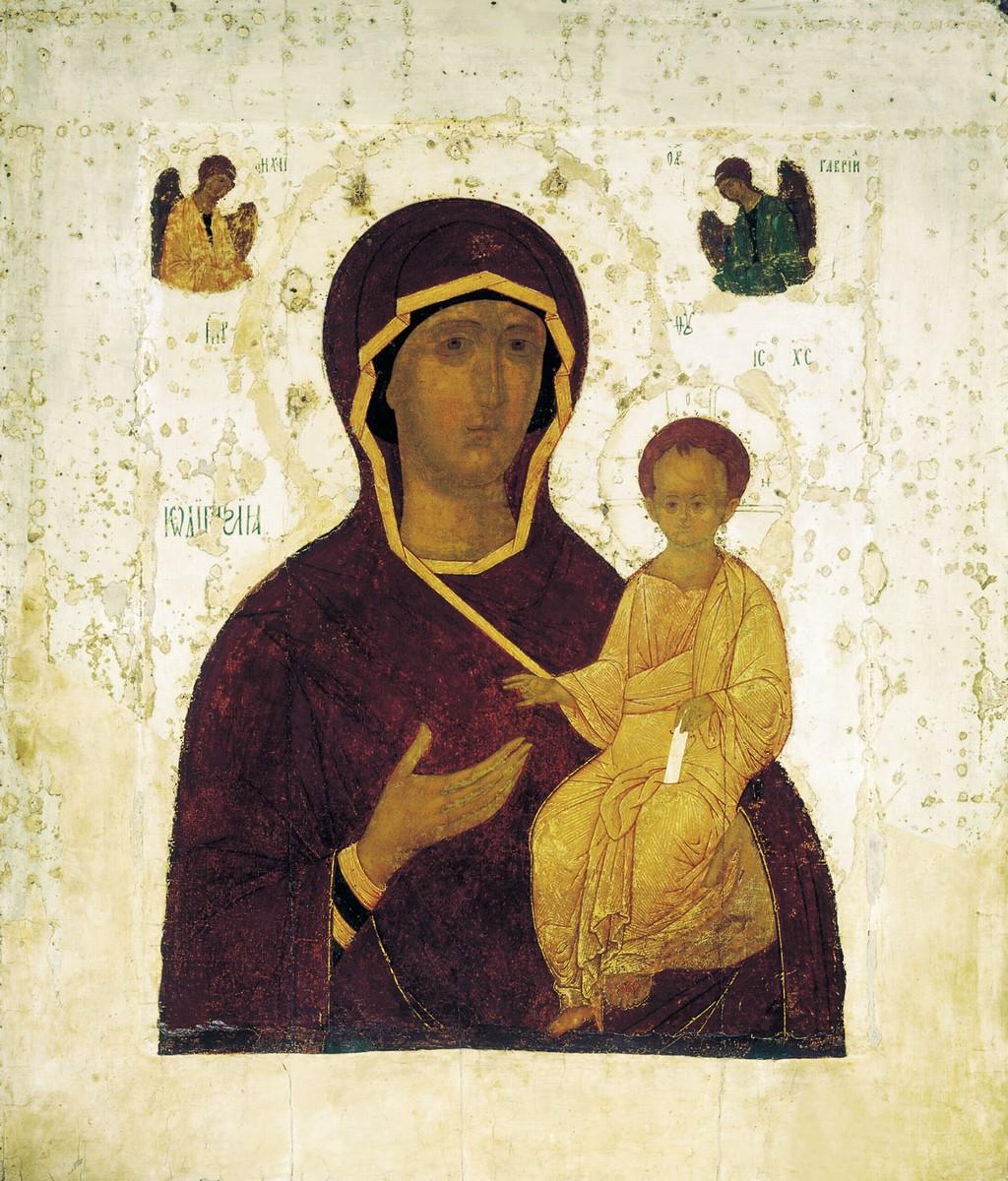

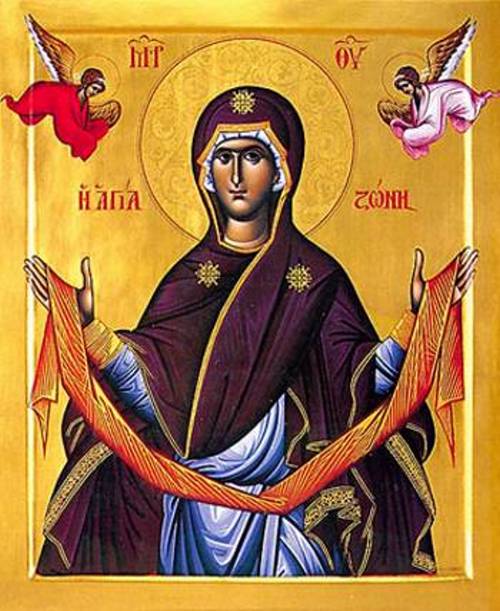
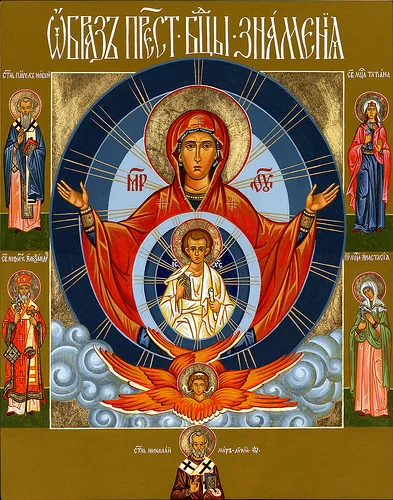
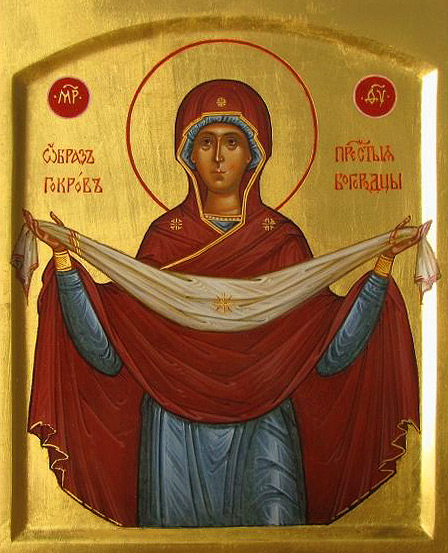
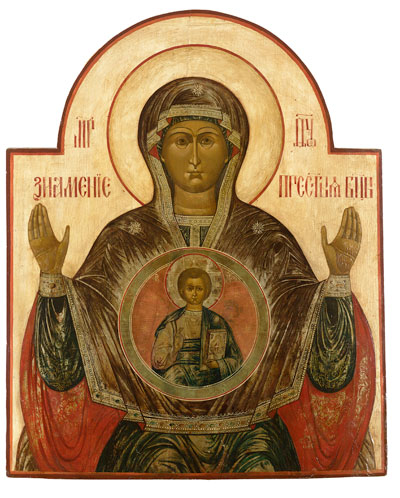
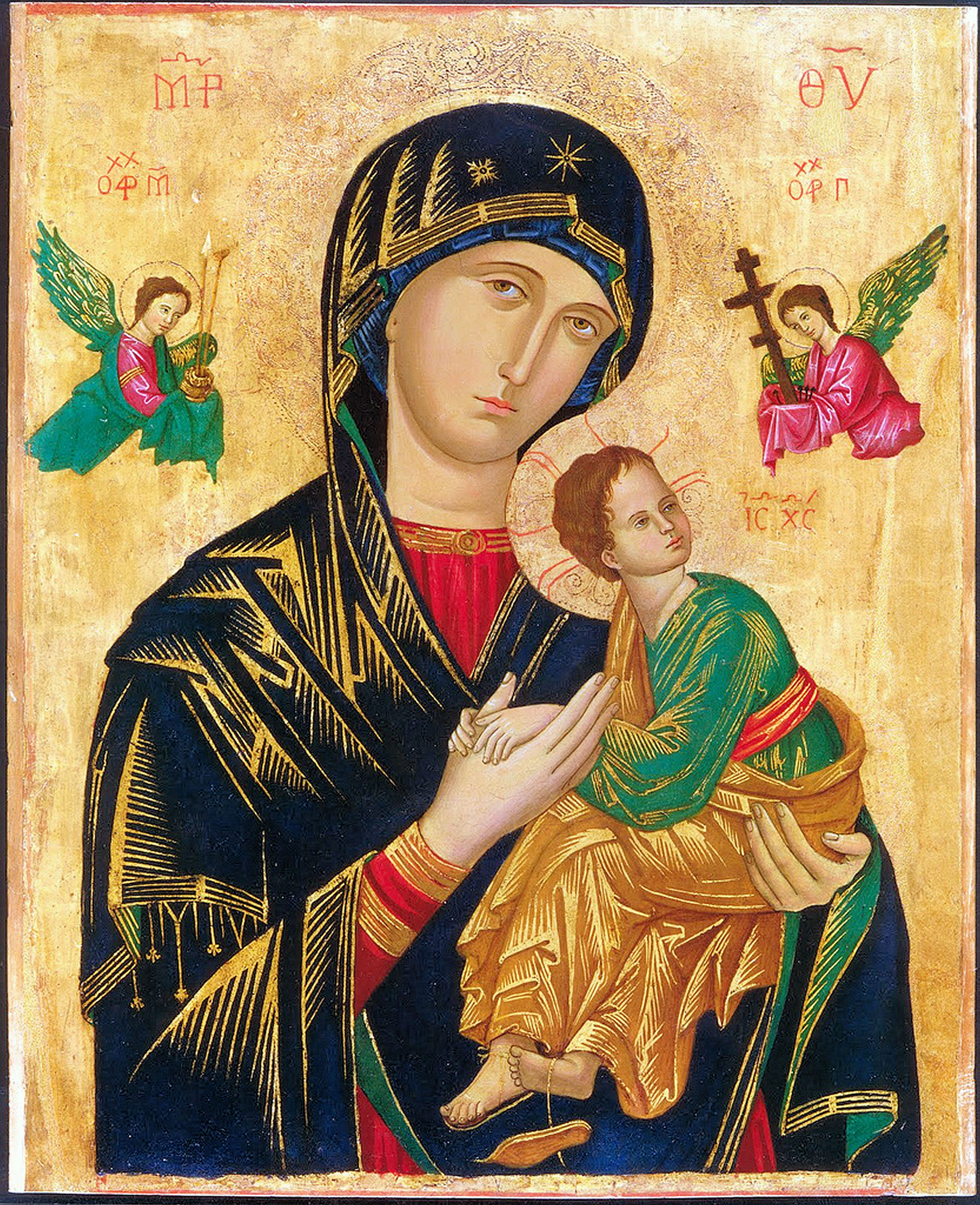
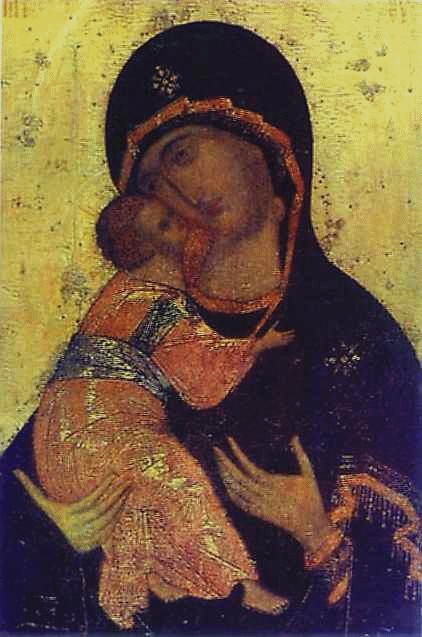
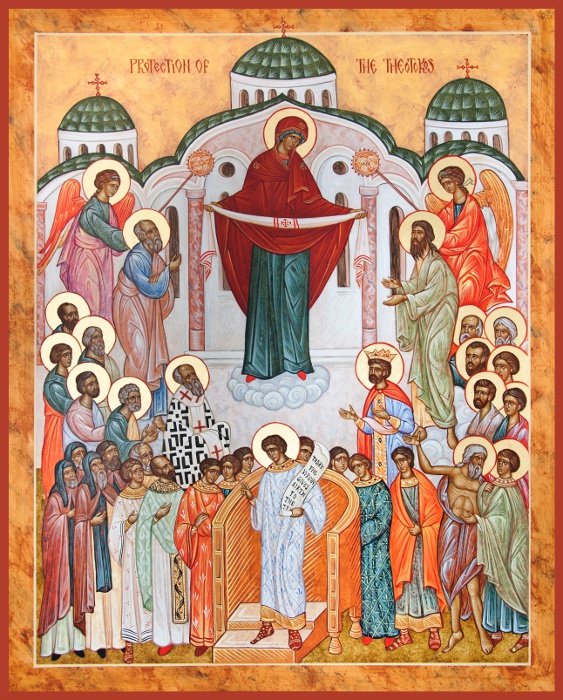
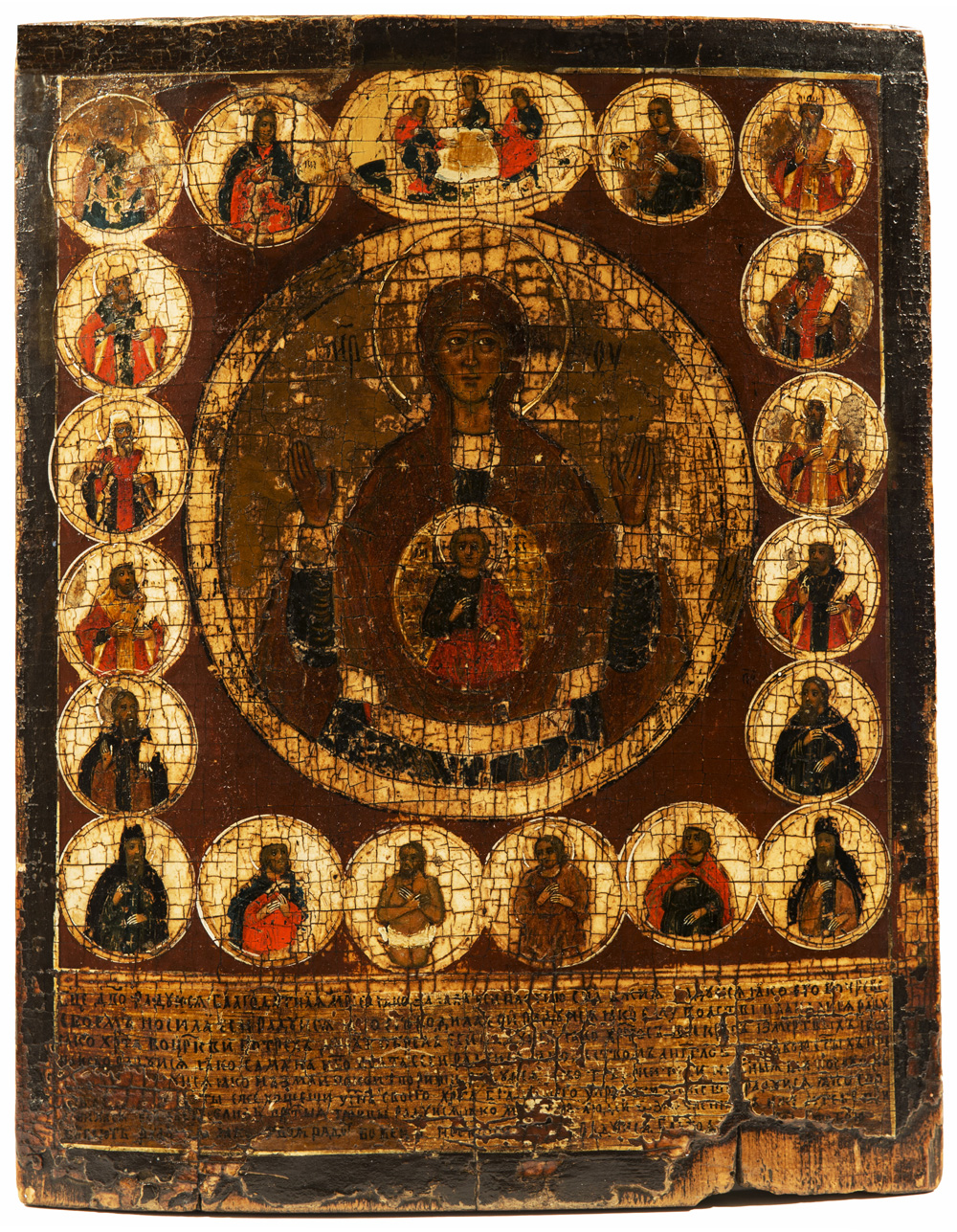



























Hail, full of grace, the Lord is with you. What joy could surpass this, O Virgin Mother? What grace can excel that which God has granted to you alone? What could be imagined more dazzling or more delightful? Before the miracle we witness in you, all else pales; all else is inferior when compared with the grace you have been given. All else, even what is most desirable, must take second place and enjoy a lesser importance...